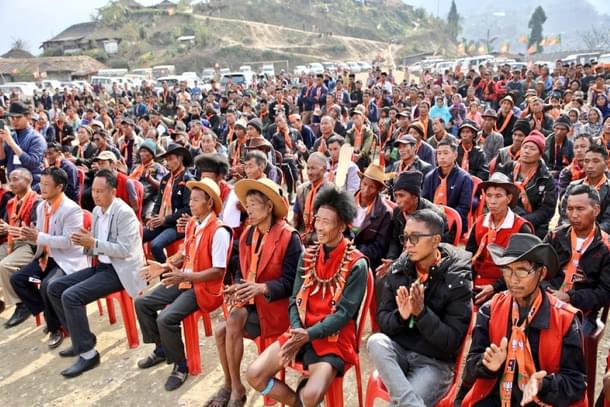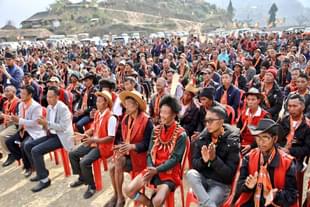Politics
Development Push With No Conditions: What Seems To Have Changed In Nagaland Since 2018
Jaideep Mazumdar
Feb 20, 2023, 03:17 PM | Updated 03:17 PM IST
Save & read from anywhere!
Bookmark stories for easy access on any device or the Swarajya app.


Nagaland has, for many decades now, been associated with insurgency and its resultant curse of backwardness and poverty.
Though encounters between militants and security forces have become rare ever since a truce was reached with the leading insurgent group — the faction of the National Socialist Council of Nagaland led by Thuingaleng Muivah, or the NSCN (M) — the shadow of insurgency has always loomed large over the state.
The exclusive focus of successive state governments has always been on maintaining peace and keeping insurgency at manageable levels. And that has hindered development.
Be it developing physical infrastructure or providing access to even rudimentary healthcare and education, Nagaland had fared abysmally. It ranked behind most other states in terms of sanitation, piped water supply and electricity to households etc.
Leave aside rural and semi-urban areas, even state capital Kohima used to sport a tired, dusty look with potholed roads, broken sidewalks, overflowing drains, acute power cuts, intermittent water supply, dilapidated school, college and hospital buildings and a barely-functioning government delivery mechanism.
There was little attention paid to social welfare and even centrally-funded projects were characterised by large-scale leakage of funds. Above all, the common citizen lived under a suffocating climate of fear and uncertainty.
Unemployment was rife, and few livelihood opportunities were available. The resultant brain drain made things only worse and a general sense of hopelessness had gripped the state.
In 2018, the Assembly elections brought the NDPP-BJP alliance to power. That year may well go down in Nagaland's history as the 'turnaround year' for the state.
“Nagas today dream of being equal citizens of the country. We dream of prosperity and a free life away from the shadow of guns and gore. We dream of good roads, hospitals and education, and we now look forward to our children making a mark in the world,” says Temjen Ao, a college teacher in Kohima.
Conversations with Ao and others suggest that a good number of the voters in Nagaland today look forward to leading a normal life with dignity and honour, a life without the hazards that insurgency induces.
“Active insurgency ended with the ceasefire agreement between the Government of India and the NSCN(IM) in 1997. But that did not ensure the dawn of complete peace. Counter-insurgency operations by security forces continued, and there was intermittent violence. The fear of violence, of getting caught in a crossfire between security forces and insurgents, of being mistaken for a militant and shot at, of being taken in for interrogation on suspicion of supporting insurgency etc remained,” said Temsula Jamir, a prominent social worker in state capital Kohima.
Modi Government’s Efforts To Usher In Peace
After the BJP came to power in New Delhi in 2014, the Narendra Modi government started focusing on paving the road to peace in Nagaland.
“Talks between the Government of India and the NSCN had been ongoing since 1997 and many rounds of negotiations were held. But some intractable hurdles always cropped up and a final solution seemed illusory. But things changed after 2014 and the Government of India started making a sincere and serious effort in finding a solution. The signing of the Naga framework agreement in 2015 gave the talks a solid foundation and laid down a concrete roadmap,” said BJP state president Temjen Imna Along.
A senior IAS officer posted in the Ministry of Home Affairs (MHA) who has been involved in the Naga talks told Swarajya that unlike in the past, the PMO started monitoring the progress of the talks since the signing of the framework agreement.
“Under Prime Minister Modi, the new thinking was that while talks will go on, a simultaneous push has to be made for the development of Nagaland. Accordingly, a number of infrastructure projects were sanctioned, and the Union Government started taking a very active interest in healthcare, education, rural electrification, water supply, sanitation etc. Allocations to Nagaland under the Jal Jeevan Mission, Ujjwala Yojana etc were not only enhanced, the Union Government started strictly monitoring the implementation of such schemes in the state,” he said.
The results were soon evident. “For the first time, we saw development was happening in Nagaland. New roads started getting constructed and existing ones upgraded, water pipelines were being laid, schools and hospitals were getting refurbished, power supply started improving and there was a buzz of progress all around. It finally dawned on us that Nagaland was emerging out of the dark tunnel and into a fresh new dawn,” said T Yepthomi, a retired bureaucrat.
The earlier mindset in New Delhi, said Chief Minister Neiphiu Rio, was that Nagaland would progress only after a final solution to the Naga issue.
“But under Prime Minister Modi, the approach is that while talks will go on, development also has to happen concurrently. Progress cannot be conditional on the final outcome of the talks,” he said.
His fresh approach appears to have made a difference to Nagaland. Since the state’s development is no longer tied to the ongoing talks on the ‘Naga issue’, the psyche of the people has also changed.
“Earlier, everyone was obsessed with the Naga issue and talks between New Delhi and Naga groups, but now, everyone is thinking of studying, working, earning more and improving their lives. Everyone sees progress happening, and that spurs greater resolve to become honest, hard-working citizens,” said Jaob Zhimomi, a prominent businessman in Dimapur, the state’s commercial capital.
There is acknowledgement of the fact that a lot more needs to be done in terms of bringing Nagaland at par with other states of the country as far as healthcare, education, infrastructure and other indicators are concerned.
But a start has been made and people of Nagaland have developed a stake in the state’s development. That has never happened before.





